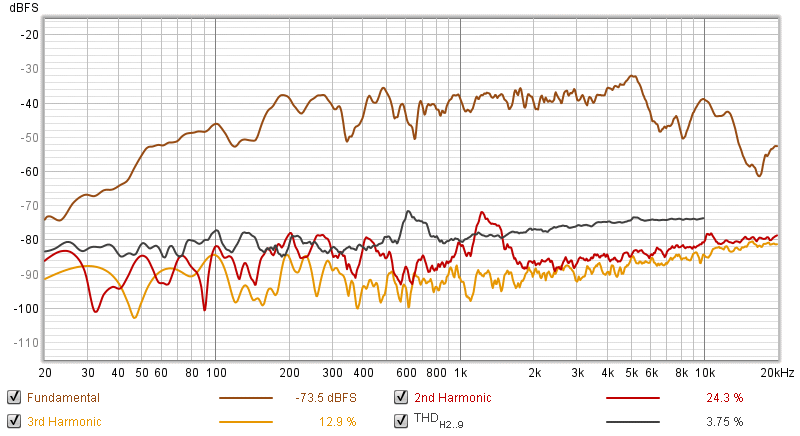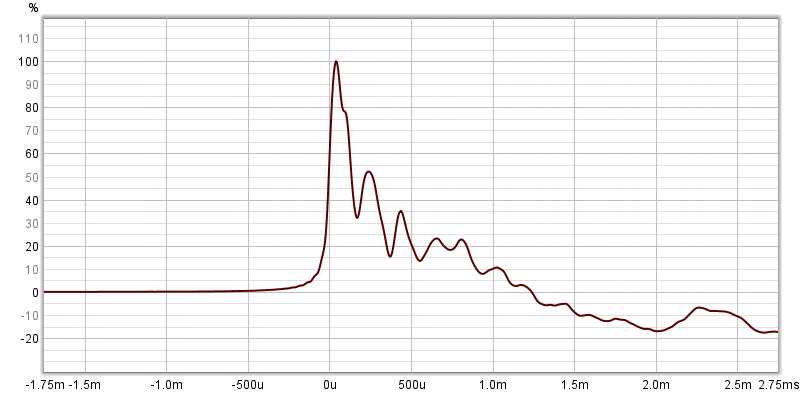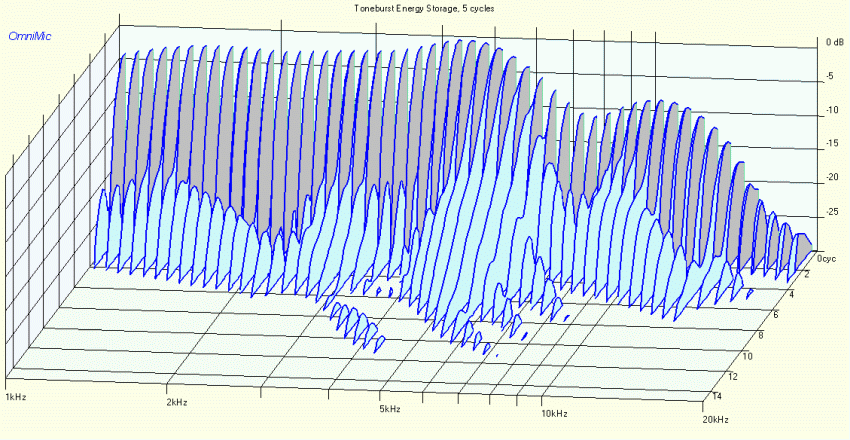|
Markaudio CHP-70-P Gen2 Frequency Response
Measured Frequency Response

The frequency response above is with the CHP70 mounted onto a sealed box of 7 liters. Baffle width is 8″. Generally, the response is similar to the published FR except the treble is slightly higher than the midrange. This is due to the effects of a baffle step whereas the publish FR is done with an IEC baffle.
Harmonic Distortion
The Total Harmonic Distortion (H2~9) is at 3.75%. This is high but it can’t be help because there’s no tweeter for the treble. The cone breakup is used to emulate the treble. The question is how well is the masking. If we can’t hear it, then it’s fine.
Step Response
The CHP70 Step response is clean and fast. There’s no hesitation on the leading edge. The apex is at an astonishing 33 microsec. The reaction of this CHP70 is almost instantaneous.
Waterfall
The Waterfall plot shows the strongest artifacts occurs at 5kHz. This is exactly where the peak in the FR plot is seen. I am not too concerned with this because the CSD window is greatly magnified at 2msec.
Toneburst Energy Storage

The Toneburst plot provides a clearer picture of the artifacts. The light blue slices are the unwanted, excess energy (artifacts). In this plot, the Z-axis is in cycles instead of time as in the Waterfall. The ones that are most likely to smear the music are those between 1kHz~2kHz.
Spectrogram

The green streaks in the Spectrogram are about 50dB below the fundamental. Notice some of them extends to 5msec. I didn’t hear any smearing during auditioning but microscopically, they are there.
Summary
The Markaudio CHP70 Gen2 is not without her flaws. I picked up some light peaking in the upper midrange during auditioning. The vocals are a bit shouty too. A baffle step compensation of 2dB~3dB would flatten the response. Fortunately, the treble is not brittle or harsh. Obviously there’s no upper treble but it’s a minor sacrifice considering this is a full range driver.
For $36, the CHP-70 Gen2 is a better buy than the SB12PFCR25-4 and the SB16PFCR25-4 coaxials. Her response is not flat like the Fountek FE85 but she sounds excellent.
Loading the CHP-70
In my first test, I mounted the CHP70 onto a 1.5 liters sealed box. My intention then was to see how she fares as a midrange driver. The bass was obviously lacking in such a small box.
In this audition, I mounted the CHP70 onto a 7 liters sealed box. Now the tonal balance is much better. The bass is more apparent though not as loud as the midrange. But surprisingly, the upper bass is punchy, tight and articulate. She is quite enjoyable to listen to in a 7 liters sealed box.
When supported with a subwoofer, this sealed 7 liters will be awesome. This configuration is ideal for users that want simplicity. One can either use a bandpass sub or a direct radiating woofer to extend the bass to 40Hz. Try not to lose the upper bass of the CHP70 in the process. That’s where she shines.
I have not exhausted the full potential of this CHP70. My next test is with the CHP70 in a bass reflex and possibly a TQWT (Tapered Quarter-Wave Tube). More to come.
Unless otherwise stated, all measurements were made with the mic at 36 ins, tweeter axis. Impulse Window=5ms. No smoothing applied. |







